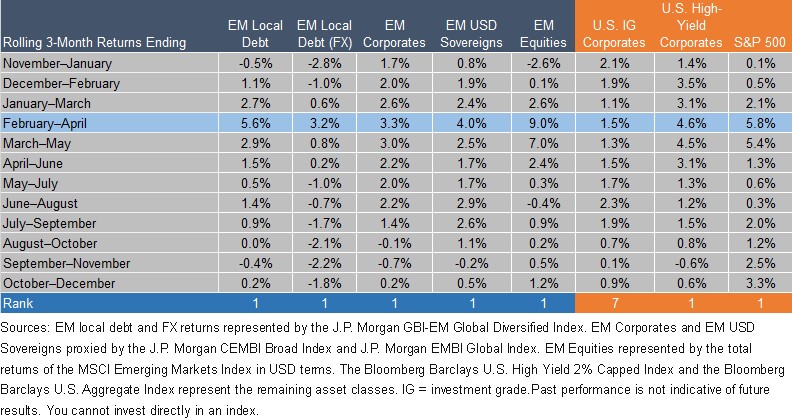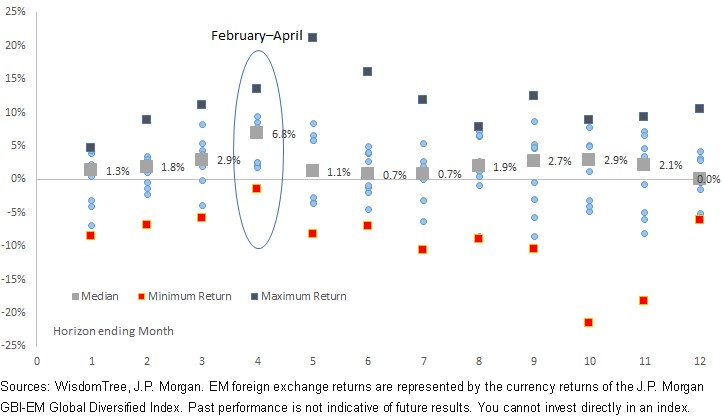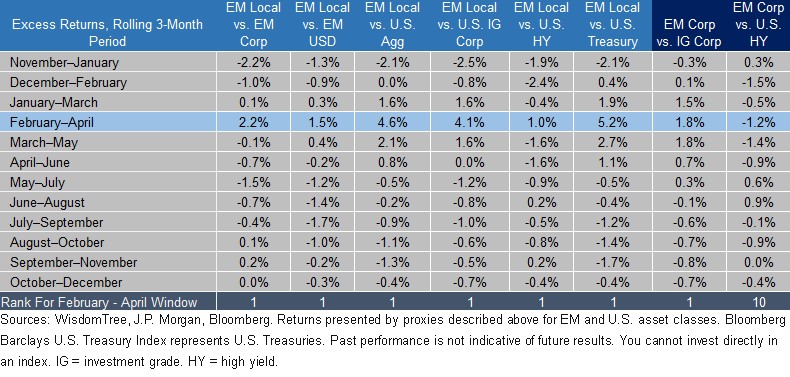
For definitions of indexes in the chart, visit this glossary.
By Rick Harper, Head of Fixed Income & Currency, WisdomTree
Special to the Financial Independence Hub
So far this year, emerging market (EM) bonds, currencies and equities have outperformed many corresponding U.S. asset classes. The EM rally stands in marked contrast to EM disappointments in January the past three years and is all the more surprising given struggles in both Mexico and Turkey. Investors can now look forward to an investment window that recently has been characterized by EM outperformance and strong absolute returns. Over the last 11 years (the inception of the local debt index1), the three-month investment window from February 1 through April 30 has, on average, produced the strongest returns for EM assets, in particular EM local debt and EM equities,2 and generated the fewest and the smallest shortfalls.
As seen in the table above, EM performance within the February-through-April window is distinct from other three-month investment windows. EM local debt, corporate,3 USD-based sovereigns4 and equities all post their most consistent performance during the window. While other windows tend to be lifted by greater one-time gains, the gains during the early spring period tend to be consistent, and losses are less frequent and shallower in scope.
A Spotlight on EM Local Debt
Among the bond sectors, EM local debt shines brightest during this period, generating substantial excess returns versus EM corporate and EM USD sovereigns. Positive contribution from foreign exchange (FX) is a significant piece of this excess return performance. The local bond returns are robust but still lag both EM corporate and USD-denominated sovereign bonds in isolation. In particular, the falling rate environment has been a very supportive tailwind for much longer-duration USD sovereign debt market proxies. The estimated 3% boost from FX gains pushes local debt to the fore.
EM Local Debt: Distribution of Returns for Rolling Three-Month Windows
(1/1/06–12/31/06)
The strength in local debt and currency performance was also broad-based. On an aggregate level, each region (Latin America, Europe, Africa and Asia) registered its best average performance during the February –through-April window. 65% of the individual countries posted their best average returns during this window. This number grows to 80% if you expand it to the top two windows. On a given year, 80% of the countries represented by local debt issuers typically produced positive returns.
EM local debt has also outperformed relative to U.S. high-yield debt, U.S. investment-grade corporates and the Bloomberg Barclays U.S. Aggregate Index (the Agg) during this period. The sole negative February-through-April return period for EM local debt was a loss of 1.4% in 2015; the other 10 were positive. 2015 was also the only February-through-April window in which the Agg outperformed EM local debt.
Average Excess Returns of EM Local Debt versus Other Fixed Income Assets, Rolling Three-Month Periods
for Horizons Ending 3/31/06–12/31/17
Catalysts and Potential Investment Implications
What is behind this? A couple of reasons come to mind. In the last few years, U.S. economic momentum slipped sharply in the first quarter, reducing expectations for Federal Reserve vigor and pressuring the dollar against most currencies.5 Indeed, the United States dollar has tended to fall in value against both emerging market and developed market currencies during this 11-year period. Dollar weakness typically correlates with higher commodity prices, which lends support to some of the commodity-intensive EM countries. (The Bloomberg Commodity Index also enjoyed its strongest returns in the February-through-April window over the 11-year period.) Currency performance in Russia, Colombia, South Africa and Brazil, are significant contributors in the February-through-April anomaly. Anxiety about the future trajectory of Chinese growth has been a constant source of concern before Chinese New Year in January, yet seems to dissipate in the months immediately thereafter. The smaller drawdowns in this window (relative to other three-month horizons) also suggest the absence of a significant risk event. Interest rates were largely well behaved, and credit spreads have tightened in the first four months of many of the last 10 years.
Unfortunately, it does end rather quickly. Over the last 11 years, May has commonly produced a sharp setback for EM FX, and returns over the May-through-July period have tended to be relatively modest for local debt (average is .5%; median return is .7%).
Still the February-through-April period has provided a seasonal window to tactically increase exposure to non-U.S. assets. Among EM debt options, it has been a window in which EM local debt has traditionally shined relative to both other EM debt options and domestic fixed income options. Despite the strength of recent performance, local debt yields could offer a considerable cushion relative to other credit products, including U.S. high yield. EM fundamentals have been gaining strength and are steadily outpacing those of developed market countries. Relative to 2013, EM economies are not nearly as extended, with fiscal budgets and trade balance in much better shape. The concept of emerging markets having a thicker skin than in years past seems appropriate given the recovery we have seen in fundamentals, and the February-through-April window could offer an opportunity to take advantage.
1As measured by the J.P. Morgan GBI-EM Global Diversified Index. Inception: 12/1/05.
2As measured by the MSCI Emerging Markets Index.
3As proxied by the J.P. Morgan Corporate Emerging Market Bond Index – Broad (CEMBI Broad).
4As proxied by the J.P. Morgan Emerging Market Bond Index – Global (EMBI Global).
5Source: Bloomberg, as of 1/31/17.
 Rick Harper serves as the Head of Fixed Income and Currency for WisdomTree Asset Management, where he oversees the firm’s suite of fixed income and currency exchange-traded funds. Rick has over 22 years investment experience in strategy and portfolio management positions at prominent investment firms.
Rick Harper serves as the Head of Fixed Income and Currency for WisdomTree Asset Management, where he oversees the firm’s suite of fixed income and currency exchange-traded funds. Rick has over 22 years investment experience in strategy and portfolio management positions at prominent investment firms.
Commissions, management fees and expenses all may be associated with investing in WisdomTree ETFs. Please read the relevant prospectus before investing. WisdomTree ETFs are not guaranteed, their values change frequently and past performance may not be repeated. Past performance is not indicative of future results. This material contains the opinions of the author, which are subject to change, and should not to be considered or interpreted as a recommendation to participate in any particular trading strategy, or deemed to be an offer or sale of any investment product and it should not be relied on as such. There is no guarantee that any strategies discussed will work under all market conditions. This material represents an assessment of the market environment at a specific time and is not intended to be a forecast of future events or a guarantee of future results. This material should not be relied upon as research or investment advice regarding any security in particular. The user of this information assumes the entire risk of any use made of the information provided herein. Neither WisdomTree nor its affiliates provide tax or legal advice. Investors seeking tax or legal advice should consult their tax or legal advisor. Unless expressly stated otherwise the opinions, interpretations or findings expressed herein do not necessarily represent the views of WisdomTree or any of its affiliates. “WisdomTree” is a marketing name used by WisdomTree Investments, Inc. and its affiliates globally. WisdomTree Asset Management Canada, Inc., a wholly-owned subsidiary of WisdomTree Investments, Inc., is the manager and trustee of the WisdomTree ETFs listed for trading on the Toronto Stock Exchange.



